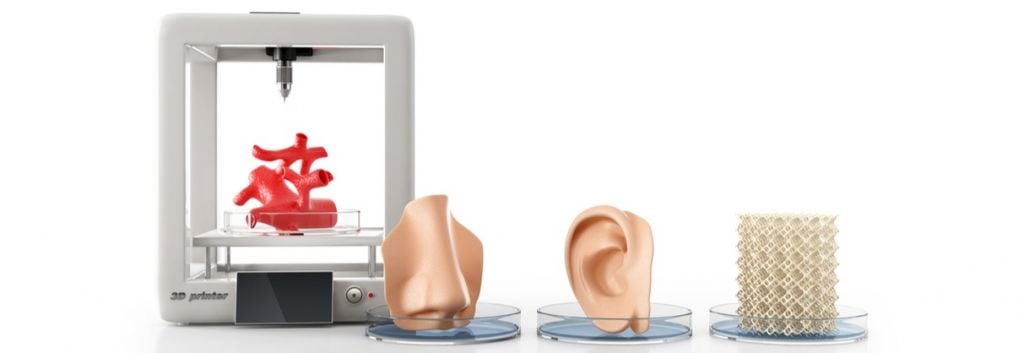A lot of fantasy surrounds bioprinting: everyone has in mind advanced reactors that would print, in just a few seconds or minutes, a missing body part or even a fully functioning organ. Still, as the technology gains in maturity, it’s no longer utopian to imagine tissue implants created from scratch.
The bioprinting market is expected to weigh globally €2.1Bn by 2025, and European companies are willing to conquer their own share. Since the full ban on animal testing for cosmetics in 2013, the wellness industry has been the most important supporter for bioprinting in Europe. For instance, French leader of beauty cosmetics L’Oréal partnered in 2015 with the American startup Organovo, considered a bioprinting pioneer, to reduce the cost of its skin samples used for testing cosmetics.
For the French startup Poietis, early support on its laser-assisted bioprinting technology came from BASF. The German chemical group initially intended to improve their proprietary skin model for cosmetics testing. Now Poietis’ first commercial product, Poieskin, is available to all European customers willing to assess “cosmetic ingredients and finished products.”
Another big application of bioprinting is in vitro pharmaceutical testing. Just like organs-on-chips, 3D-printed tissues are a complementary tool for testing toxicity. In the US, Organovo has already developed models to study liver and kidney tissues. CTIBiotech, in Lyon, France, bioprints patient-specific tumors to test anticancer drugs.
But most companies in the business work to be part of bioprinting’s long-term goal: regenerative medicine. The technology has the potential to create 3D-printed transplants customized for each patient, and hence get around organ donor shortage. But there are several challenges to overcome before that’s possible.
“Vascularisation remains the biggest technical challenge. There’s still a lot to learn on tissue maturation in vitro before we can handle more complex tissues,” notes Christophe Marquette, researcher at the French bioprinting platform 3D.FAB.
BioAssemblyBot training for in vivo ear reconstruction through bioprinting (ICBMS, 3D.FAB and Dr Christophe Marquette)
A lot of ongoing research tests different biocompatible materials to use as bioinks – extracellular matrix, synthetic polymers, bacteria, stem cells… There’s no one-size-fits-all formula to 3D-print both soft and hard tissues. On the contrary, bioinks need to be tailored to obtain either cornea, bone, cartilage or nerve tissue. Other printing parameters, like speed and bioink viscosity, need to progress if we’re to see 3D-printed large volumes such as inner organs.
3D-printed skin, with its small volume and simple vasculature, is logically the best candidate for a first human transplantation. This could happen only in 3 to 5 years according to Poietis’ CBO Bruno Brisson. 3D.FAB expects to test its proprietary bioink in a clinical trial next year, in collaboration with surgeons and the company LabSkin Creations. This ink, made of autologous cells, would be 3D-printed directly on wounds, to help the healing process in patients suffering from severe burns.
The first transplantation of 3D-printed lungs or heart isn’t around the corner, though there’s already enough progress to envision viable options to repair organs, for instance after a heart failure. Bioprinting is making its way to the market, but it’s not bringing the incredible medical solutions everyone has in mind just yet.

Ludovic Fery is a freelance science writer from France. The junction between life sciences and emerging technologies (AI, 3D printing…) is what captivates him most in the biotech industry.





